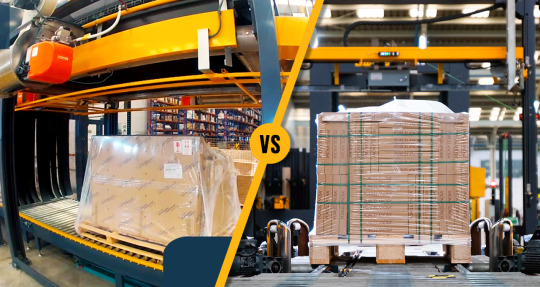#stretch hooder film
Text


What Is Stretch Hooding?
In the packaging, logistics and transportation industry, ensuring the safe and secure delivery of palletized goods is paramount. Among the various packaging methods available, stretch hooding stands out as a highly effective and versatile solution.
Stretch hooding is a packaging method commonly used to secure and protect palletized goods. It involves using a stretchable plastic film, known as stretch hood film, which is applied over a load of goods on a pallet.
The stretch hood is typically made of linear low-density polyethylene (LLDPE) and is designed to fit snugly over all five sides of the pallet load (leaving no open top side), providing stability and protection during handling and transportation.
Stretch hood film is a popular choice across many different industries because it provides strong, resilient packaging that adapts to different load shapes and sizes, enhancing protection and stability throughout the supply chain.
There are several advantages of using stretch hood film:
Improved Load Stability: The tension in the film holds the goods firmly in place, reducing the risk of damage during transit.
Highly Durable: Due to its ability to stretch, this type of film is incredibly durable, making it resistant to tears and punctures even on odd-shaped products.
Enhanced Protection: The polythene film acts as a barrier against environmental factors like dust, dirt, and moisture.
Versatility: It can accommodate various load sizes and shapes, making it a flexible option for different types of products.
Environmental Benefits: Stretch hood films are often recyclable, contributing to more sustainable packaging practices.
Cost Efficiency: Stretch hooding can be more cost-effective than other packaging methods like shrink wrapping, often using up to 50% less material!
At Quick Pak Inc, we supply stretch hood film to benefit your packaging needs, securing goods through all stages of the supply chain. Contact us today @ 813 242 6995 or [email protected] to discuss your stretch hood packaging requirements.
#hooder film#pe hodder film#stretch hooder film#quickpakinc#resin pricing#stretch film pricing#free pallet wrapper
0 notes
Photo

Stretch Hood Film and Shrink Hood Film
What Is Stretch Hooder Film? Introduced back in the 1980s, the stretch hooder type of film and method of palletizing products offers a range of different benefits with respect to distribution chain performance, reliability, operating costs, speed, and sustainability. Stretch hooder film or hooder film is a type of tubular film sealed one end; while the other end of the film is open and designed to stretch over your palletized load. It involves applying a gusseted, stretchable polyethylene hood to a pallet via a specialized piece of equipment or machinery.
How Is Stretch Hooder Film Applied? The "hood" on stretch hooder film is created from gusseted tubing, and the total height of the pallet load is automatically measured as the pallet enters the machine — making sure the exact amount of film used is precisely dispensed and appropriate for the job. Each film application is strategically cut to the proper length, sealed with heat on the top end, and then collected on four 'fingers' of the highly specialized application equipment.
The fingers are engineered to stretch the film horizontally until the dimensions of the film are just larger than the dimensions of the load. Afterwards, the fingers will draw the stretch hood film over the pallet, unrolling it as it goes.
By alternating the unrolling rate, a degree of vertical directional stretch is gained to provide a superior hold for the pallet. Once it reaches the bottom of the pallet, the fingers will release the film, and the film is then securely wrapped under the bottom of the pallet.
Benefits of Stretch Hooder Film.
Exceptional, proven performance across several industries.
Transparence allows the ease of identifying errors and damage.
Higher elastic recovery for secure packaging.
Outstanding potential stretch performance up to and more than 100%.
Vertical stretch potential for optimized load stability.
Much stronger than standard corrugated packaging solutions.
Higher resistance to tearing and puncturing.
Excellent sealing.
Heat Shrink Hooder Film: As the oldest type of pallet packaging with polyethylene film, heat shrink hooding was originally introduced back in the 1960s. Until the invention of newer technology, heat shrink hooding was the primary solution for providing pallet load protection and optimal stability. Heat shrink hooding film utilizes equipment that implements gusseted tubing that is sealed and cut to create a bag.
This oversized bag is then applied over the desired pallet and heat is used to shrink the plastic. The most common sources of heat for shrink hooding are liquid propane gas or natural gas, but other innovative methods are used, such as electrical heaters and infrared heaters You can choose from a vast range of different types of heat shrink hooding equipment.
Benefits of Shrink Hooder Film.
Proven, reliable performance across multiple industries.
Cost-effective solutions for specific customizations.
Decreased level of permeability.
Increased 6-sided protection from environmental elements.
Higher resistance to tears and punctures.
Outstanding sealing.
Wide operability range of temperatures.
Bolstered load stability over virtually all flexible applications.
Benefits of Stretch Hood Film vs Shrink Hooder Film
Stretch hood film offers the ability to re-align the hood and continue hooding in the event the product isn't perfectly aligned on the pallet. In contrast, you would need to stop the entire line to correct the fault with a shrink hooder you, would have to stop the entire line to correct the problem with shrink hooder film.
Shrink hooder film is especially ideal for products that are sensitive to elastic packaging stacking, such as mirrors and glass products. Yet, your ability to quickly see the contents of a shrink hood wrapped pallet may be hampered because the shrinking process causes the film to become hazy or milky.
For more information and pricing on both films call 813 242 6995 or [email protected]
0 notes